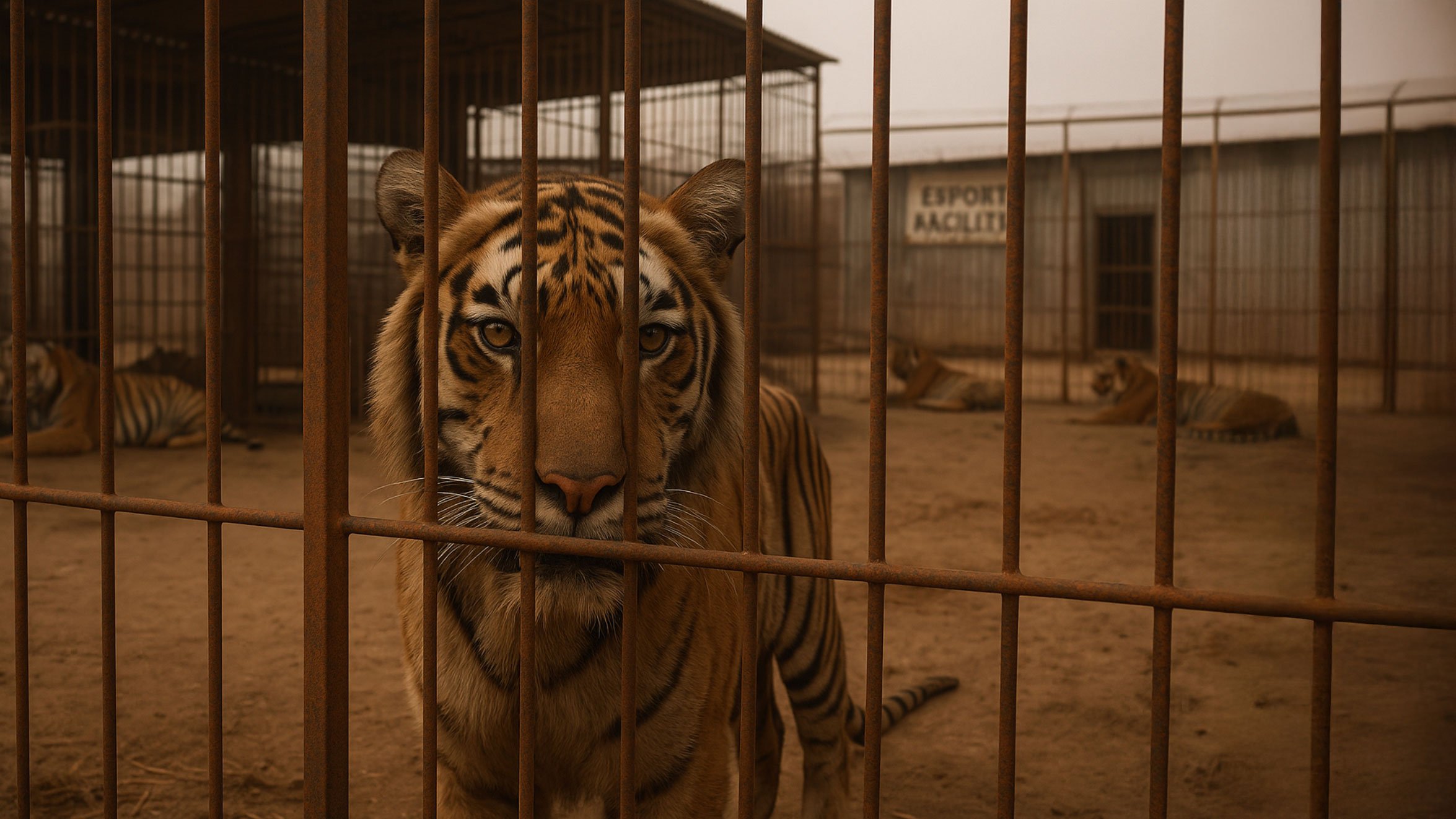Lion Facts
Lion with amber eyes gazing out over the plains
Lion - Panthera leo
Lion cubs Mufasa and Sarabi rescued by Big Cat Rescue
This "King of Beasts" once roamed over most parts of the world including Africa, North America and Eurasia. Today, however, they are restricted to the savanna, open expanses, and grassy plains of Africa, and to a small area of western India. There are about 15,000 lions in the wild today. Just ten years ago that number was closer to 50,000. The shrinking numbers are due to hunting and overpopulation of humans.
One hundred and fifty years ago, there lived a subspecies of lion, Panthera leo persica, which was found from India to the Middle East. There are only an estimated few hundred alive today. They can be found in the Gir forest sanctuary in Gujarat, in western India. A sanctuary was set up in 1966 in the Gir forest to try and protect the surviving numbers of Asiatic Lions in India. They are endangered due to hunting and other human factors.
The Lion is the only cat that lives in large social groups, shares its territory, and regularly hunts together. The Lion's diet consists of wildebeests, antelope, zebras, wild pigs, buffalo, impalas, and other hoofed mammals. The Lionesses do all the hunting in large number of groups or pairs. Prey will be approached with stealth until it is in range, then the cats will lunge and kill the prey by biting its neck. Lions are the dominant carnivores in their habitat and will drive away competitors or even kill them.
The Lion's head and body can be up to eight feet, two inches, and tail up to three feet, five inches. Its weight can be up to 550 pounds.
Lions are primarily ground-dwellers, but occasionally jump up tree branches. Most Lions will remain in the same territory all year long, however some are nomadic and follow the seasonal prey.
Lions live together in a pride based upon a group of related females (Lionesses) and their cubs. Surprisingly, the pride is led by a dominant female. When a new male joins a pride it will drive away the other males and kill any remaining cubs, then mate with the females to produce his own offspring.
A Lioness will give birth to up to six cubs after a gestation period of 15-17 weeks. All of the Lionesses in the pride share in the rearing of the cubs and the males may even be playful with them.
Cameron Lion at Big Cat Rescue
Common Name: Lion
Kingdom: Animalia
Phylum: Chordata (Vertebrata)
Class: Mammalia
Order: Carnivora
Family: Felidae
Genus: Pantherinae Panthera
Species: leo
NOTE: The lions discussed below are African and Asian.
Misc: The Lion is the only cat with tufted tails (both sexes) and manes (males), with the manes allowing them to be the only cat which you can distinguish gender from a distance. They are also the only true social cat and live in groups called "prides." The lion has often been called "the King of the Jungle," but that would be most inaccurate. The lion's habitat does not include the jungle, and therefore, the correct phrase would refer to the lion as "the King of Beasts."
Sub-species: Of the known sub-species of lion there seems to be an agreement on 2 as far as genetics go - Pantherinae Panthera leo leo - the African lion, and Pantherinae Panthera leo persica - the Asian lion. Regardless of the area of Africa a lion is found in today, their DNA analysis has shown them to be the same, whereas there is a difference between African and Asian. As of the time of this writing, the Barbary lion has never been tested and compared to these results, and may in fact be a third and distinct lion sub-species.
Size and Appearance: Second only in size to the Siberian tiger among the felines, the lion is the largest carnivore in Africa, and the second largest feline predator in the world. Average males weigh 385-550 pounds, and females weigh 250-450 pounds. The males reach an overall length of 11 feet from the tip of the nose to tip of the tail, and females being just a bit shorter. Lions have a uniformly tawny coat, and the shades of it may vary from light to dark. In the Timbavati region, white lions are found, which is a form of leucism as opposed to albinism. Black (melanistic) lions have not been observed and reports of black lions in captivity have never been confirmed. Males possess a mane and it can range in colors from blonde to red to brown to black. It covers their head, neck and chest, and its development is believed to be strongly influenced by testosterone. Their ears have black spots on the backs, which stay black throughout their lives, unlike the black rosettes that cover their bodies when they are born.
Lion Range
Habitat: The lion prefers to live in open woodlands and thick bush, scrub, and tall grassy areas. The lion can and will tolerate a wide variety of habitats, absent only from rain forests and desert interiors. While lions drink water regularly when it is available, they can survive by obtaining their moisture requirements from their prey or from tsama melons. This allows them to survive in very arid climates.
Distribution: The lion was once found from northern Africa through southwest Asia (extinct in most countries within past 150 years), west into Europe (extinct 2000 years ago) and east into India (relic population of 350 in Gir Forest only). Today, the majority of Africa's lions can be found in east and southern Africa, with about 1,500 in West Africa. Most of the lions today exist inside protected areas. 2007 surveys estimate only 15,000 lions to be left in the wild and most of those are on game parks where they are hunted as trophies.
Reproduction and Offspring: Lions will reproduce any time of the year, and all females of reproductive maturity will breed at the same time. This allows them to give birth in synchrony with each other, thereby sharing the suckling responsibilities. Any lactating female in a pride will suckle any cub that belongs to the pride. Lions give birth to 1-6 cubs after a gestation of 110 days. The cubs are born blind and helpless, and weigh approximately 2-4 pounds. Cub mortality is very high in lions, and less than half will survive their first year. Young males will leave their pride between 2-4 years if they can get away with staying that long, but sometimes they are forced out as early as 13-20 months. Females remain with their natal pride most of the time, although some will disperse and form new prides. While male lions are physically capable of reproducing at 30 months and females at 24 months, they do not generally successfully reproduce until pride membership has been firmly established.
In captivity, lions can live 20 years, as compared to 12 in the wild for males and 15-16 for females.
Social System and Communication: The lion is the only true social cat and lives in groups called prides. These prides are made up of a single male or a coalition of males (up to 7) and up to 20 females and their offspring. The males defend the females and the territory from strange males, and competition among the males is fierce. A male's average tenure over a pride is only 2-3 years, but can increase depending on the size and strength of the coalition. Groups of males do better than a lone male. Lions use a variety of vocalizations, most notably the roar. It can be heard over a distance of 5-6 miles, and serves to let other members of the pride know where they are, and as a signal to strange males to stay away. The Africans believe that the lions are speaking and saying "he inchi ya nani - yangu, yangu, yangu" or "whose land is this? It's mine, mine, mine!" Hear our roars, hisses, snarls, calls, and growl sounds HERE
Hunting and Diet: Lions are very opportunistic eaters, and will take almost any prey ranging from small rodents to young rhinos, hippos and elephants. The majority of its prey, however, is medium to large ungulates, most notably zebra, wildebeest, impala, warthog, hartebeest and waterbuck. They will stay away from adult rhinos, hippos, elephants and even giraffes. The females do most of the hunting, and the male will come and join the females after the kill is made. The females will make way for the males and allow him to eat his fill first. Males will participate on a hunt when it is a particularly large prey item - like a water buffalo - where his size and strength is required to bring down such a large animal (although enough females can do it successfully on their own). Males must also hunt during their bachelor stages, when there are no females to take care of them.
Principal Threats: Lions are generally considered problem animals whose existence is at odds with human settlements and cattle culture. Their scavenging behavior makes them highly susceptible to poisoned carcasses put out to eliminate predators. Where the wild prey is migratory, lions will predate on captive stock during the lean season, thus making the nuisance animals and easy targets for humans to eliminate.
Status: CITES: Appendix II. IUCN: Vulnerable with some subspecies Endnangered.
2003 Felid TAG recommendation: Lion (Panthera leo). One of the last SSPs to be developed for an otherwise large and widely held felid, the initiation of the African Lion Studbook in 1992 discovered that only two lions could be traced back to wild founders in Africa. All other lions in zoos, regardless of the institution's size, were acquired as public donations or from other untraceable sources. Only one purebred Asian lion remains in North America. With a target population of 350 animals, only lions with ancestors that can be traced back to the wild are accepted into the studbook and SSP. Since the SSP began, several dozen lions have been imported, primarily from South Africa, but parties interested in importing additional lions need to ensure that specimens under consideration are unrelated to animals already in this country.
In the case of Asian lions, the wild population will continue to be monitored, with future importations possible from sources within the Indian Lion EEP population. Three institutions had mate killings in the past year.
Information reprinted With Permission from the IUCN Wild Cats Book.
See Conservation Work Funded By Big Cat Rescue here:
All conservation insitu work: https://bigcatrescue.org/insitu/

































